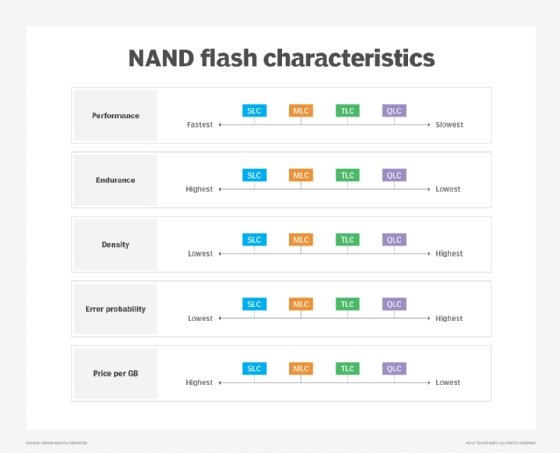
Brian Jackson - Fotolia
Is QLC NAND the right choice for you?
QLC drives can offer high storage capacity and low cost per gigabyte, but speedier alternatives may hold more appeal for some organizations. When does a switch to QLC make sense?
Many of the latest-generation solid-state storage devices are based on quadruple-level cell NAND technology. QLC is a type of multi-level cell memory that stores four bits per cell. While it is easy to assume that such devices would be technologically superior to their triple-level cell predecessors, that's not necessarily the case.
While QLC NAND devices offer the potential for higher storage capacities and a lower cost per gigabyte, they also suffer from poor write durability and somewhat sluggish performance when compared with other NAND flash devices. Even so, it would be a mistake to use QLC's shortcomings as an excuse to dismiss the technology. In some cases, it makes sense to switch to QLC NAND storage.
QLC drives often come with modest price tags, and some vendors use an integrated write cache to overcome the disk's performance limitations. As such, QLC NAND drives may be a good option for use in enterprise desktops. Replacing aging desktop HDDs with QLC-based SSDs can greatly improve desktop performance. In some cases, the performance improvement is such that you may be able to postpone your next scheduled desktop hardware refresh, which could save a considerable amount of money.
As is the case with other SSDs, QLC-based storage devices don't have any moving parts, and they consume much less power than an HDD. Transitioning desktop computers from HDDs to QLC-based SSDs could save even more money in the form of reduced power and cooling costs.

QLC drives beyond the desktop
It isn't just enterprise desktops that can potentially benefit from QLC NAND drives. Any server-based, read-intensive workload -- or workloads that don't perform significant write operations -- could potentially benefit from the adoption of QLC storage devices. This is especially true if those workloads are using rotational media. A few examples of such workloads include web front ends, streaming media servers, data analytics tools and active archives.
Solid-state storage has been around long enough that many read-intensive workloads are already running on SSDs. Replacing existing single-level cell, multi-level cell or triple-level cell drives with QLC NAND might not always be the best option, because QLC drives may not perform as well as the storage media that is currently being used. Even so, there are inevitably going to be some situations in which capacity is going to be far more important than achieving top performance. Switching to QLC drives provides an opportunity to expand overall capacity without having to revert to using HDDs.








